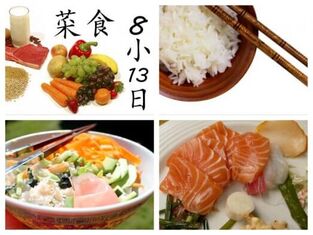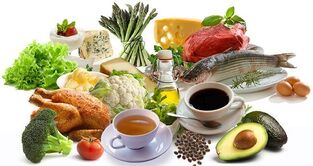The Japanese 14-day diet is a way to gain weight and a slim figure without running out of fast. The approach to product selection is special. The number of calories and compatibility of components are taken into account. Fat cells disappear quickly. During the period of compliance with the restrictions, you can lose 5-10 kg.
Japanese diet for 14 days: principles that influence the weight loss process
The principles of weight loss consist of 3 indicators:
- low calorie;
- the presence of protein components in the diet;
- lack of salt in ready meals.
Weight loss is triggered by an accelerated metabolic process. Protein increases the production of heat in the body. Cells and tissues are freed from excess fluid. This happens due to the restriction or absence of salt in the food. In addition, it is possible to eliminate edema and normalize pressure indicators taking into account age. The body receives a minimum of calories. The amount is sufficient to maintain well-being. To replenish energy, existing own reserves are used and activated.
Features:
- The assimilation of protein foods requires energy. Fat cells are used for its formation (combustion process).
- Suitable for people of different weight.
- In 7 days it takes up to 5 kg.
- Fats and carbohydrates are present.
If there are no deviations in health and there are no contraindications, it is permissible to maintain the diet for up to 30 days. The Japanese menu is made taking into account the fact that at least 100 different products should appear on the table in weeks.

The diet is strict. Psychological presetting helps avoid unnecessary emotional stress. Experts recommend repeating the method of losing weight no more than 2 times a year.
Additional effect, subject to the rules: the result obtained is maintained for a long time. To do this, you need to get out of the diet correctly (a sharp increase in the calorie content of food is not allowed). You have to give up on this way of losing weight and maintaining weight:
- pregnant women;
- nursing mothers;
- people with liver disease of varying severity;
- if there are kidney diseases;
- for diseases of the gastrointestinal tract and stomach - gastritis and ulcers.
Limitations are also imposed by violations in the field of cardiology. It is advisable to consult a doctor before starting the diet.
The fundamental principles of effective dietary nutrition
The Japanese diet for 2 full weeks has a number of principles, compliance with which will increase its effectiveness. For 15 years of existence, there are:
- Complete absence of salt (not even 2-3 g per day are allowed).
- Reduce dietary carbohydrate intake.
- The diet consists of a variety of foods.
- Meals during the day - 3.
- Amount of liquid.
- Age criteria - 18-40 years.
- Suitable for both men and women.
Dietary rules are highlighted:
- 90% of the liquid is pure water;
- fish in dishes, boiled and stewed. Frying in moderation is also allowed;
- there are no restrictions on cereals, but it is advisable to make rice and legumes prevail;
- vegetables, including cabbage, should be included in the menu;
- completely excluded simple carbohydrates;
- sugar-free kefir is allowed in the morning (for breakfast).
You cannot change the menu by yourself during the day. The priority for meat is beef. Chicken allowed. When cooking, do not use the skin. The basis of dietary nutrition is a decrease in the daily amount of calories. Snacks are not allowed. You will have to decline:
- salt (fresh food helps get rid of excess volumes faster);
- smoked meats;
- fatty foods;
- ready meals;
- fast food;
- juices;
- alcoholic beverages;
- fast food and chips.
Compliance with the basic principles allows you to accelerate metabolic processes in the body. Fat deposits will quickly disappear and be converted into energy. The nutritional program includes:
- eggs;
- coffee (freeze-dried is not suitable);
- green tea;
- chicory;
- dairy products;
- lean meat (rabbit, poultry).
Vegetables are eaten in small quantities. The amount of liquid should not be less than 2 liters per day.
Proper nutrition in the Japanese diet is built in two directions. Fat and excess volume are taken into account. If they are small, 7 days are preferable. A severe overkill will require an increase to 14 days. The basic principles of nutrition during this period include:

- Ban on the use of alternative food products (beef cannot be substituted for pork).
- Permission to use tomato juice instead of fresh tomato.
- Elimination of sugar and flour in any form.
Entry and exit from the diet should be smooth. Feature: Weight loss results will be less noticeable if there was another dietary restriction prior to the Japanese diet. It is recommended to spend one day of fasting per day before starting the diet with a normal diet. Several options are allowed: on kefir or apples, the use of boiled meat with fresh or stewed vegetables. The exit from the diet should be smooth. New products should be introduced gradually. It is recommended to include 1-2 species per week in the diet. The absence of salt in the dishes will help remove excess fluid from tissues and cells. It accounts for up to 30% of the volume and excess weight. Selected strict time limits cannot be exceeded. Impossible to reorganize the days and the menu prepared for breakfasts, lunches, dinners in places.
Pros and cons of the Japanese diet
The Japanese dietary food system has a number of advantages and disadvantages. They must be considered before starting the diet. Among the advantages are:
- a decrease in the amount of salt in the diet leads to a decrease in the risk of developing heart and vascular diseases;
- the possibility of choosing the duration of the diet - 7 or 14 days;
- kg and volumes lost will not return if the entry and exit from the diet are done correctly;
- the food included in the diet is available to everyone (no unusual or exotic dishes);
- lack of edema or elimination of them;
- the presence of protein ingredients does not lead to skin relaxation or the appearance of stretch marks in the points where the fat layer is reduced
- there are no strict restrictions on food preparation (products can be boiled, put in a water bath, stewed, fried in vegetable oil);
- vitamins and minerals enter the body with vegetable and vegetable components.
14 days is the optimal time to lose weight. The body is not stressed. The mood and vitality do not diminish. Stamina and mental alertness are kept at a high level. Performance indicators are not declining.
Cons of the Japanese diet:
- The system must not be used for gastrointestinal diseases.
- The number of meals is limited to 3 (healthy eating involves 5-6 meals in small portions).
- There are age restrictions (the diet is not suitable for older people).
There are contraindications to compliance with the restrictions in the Japanese system. You can't start it yourself without consulting a doctor first.
Illegal Japanese diet foods
The Japanese diet for 7 or 14 days contains lists of foods that should be excluded from the menu. It cannot be used even in small quantities:
- goes up (except in rare cases);
- homemade fruit and vegetable preparations (marinades, pickles, preserves);
- alcoholic beverages;
- carbonated drinks;
- juices;
- mineral water (as it contains gas);
- wheat flour;
- baked goods and bread;
- semi-finished products;
- canned food (meat, fish and vegetables);
- pastry (sweets, lollipops, pills, chocolate, cookies, pastries, cakes);
- fatty meat;
- fatty fish;
- milk;
- cereals;
- sour cream;
- mayonnaise;
- bananas (fresh, mashed, dried);
- persimmon;
- grapes (all varieties and raisins);
- sugar (white, cane);
- flavors;
- gelling ingredients;
- whipped cream;
- potatoes (and other vegetables that contain starch);
- sauces;
- condiments;
- spices.
Banned honey and the dishes it enters. During this period it is not allowed to consume sausages and sausages, boiled and smoked sausages, bacon.
Approved Products
The following products are allowed for cooking:

- kefir;
- white yogurt (organic);
- rye croutons;
- tomato juice with pulp without salt (better to make it at home);
- cheese (hard, low-fat variety);
- sea fish;
- natural coffee (without flavorings, cream and sugar);
- beef (boiled, stewed, steamed);
- chicken (boiled, steamed);
- eggs (quail, chicken) - you can boil them, add cheese, cooking method - hard-boiled;
- zucchini;
- eggplant (can be fried);
- parsnip root;
- apples (unsweetened, green);
- pears (recommended savory, for example Chinese);
- citrus fruits (oranges, lemons, grapefruits, mandarins);
- green tea (without additives);
- lemon juice;
- vegetable oils (sunflower and olive): you have to choose unrefined;
- cherries 50 g each;
- kiwi (take into account allergic reactions to the product);
- plums (only fresh, in small quantities);
- white cabbage;
- carrots (fresh, boiled, grated);
- rye bread;
Meat, poultry or fish dishes are served with a side dish. It is necessary to include them in the menu every day. The difficulty is that it will not work to "" adapt "the taste to what you are used to. Do not add spices, herbs or other methods. Salt is also not added to the dish. You cannot cook fried potatoes with bacon, kebab, butyou can include steamed cutlets and meatballs in your nutrition program.
Example of grocery shopping for 2 weeks
For 2 weeks you can buy:
- chicken eggs - 20 pieces;
- chicken fillet or breast - 900 g;
- carrots - 3 kg;
- tomato juice without salt) - 2 l;
- natural coffee ground or beans - 1 pack;
- white cabbage - 2-3 kg;
- fruit - 1 kg (optional);
- lemons - 2-3 pieces;
- fresh sea fish (whole carcasses) - 2 kg;
- unfrozen fish fillet - 1 kg;
- hard cheese, low in fat - 200 g;
- melons and pumpkins - 2 kg;
- vegetable oil - 0, 5-1 l;
- lean beef - 1 kg;
- green tea - 1 pack (without additives).
It is recommended to purchase kefir and yogurt as needed to keep these products fresh.
Japanese diet for 14 days: menu, table
The nutritional program is based on a complete menu with a certain amount of calories. Menb by day (for each of 14):
| Diet Day | Breakfast | Lunch | Dinner |
| 1 | Coffee (200 ml) without sugar and milk or the same amount of green tea | Chicken eggs (hard-boiled) - 2 pieces, white cabbage leaves steamed with vegetable oil (150 g), homemade tomato juice (200 ml) | Steamed or lightly fried fish without garnish until softened (200 g) |
| 2 | Natural coffee, ground, toasted, without milk and sugar, rye bread (1 piece) | Boiled cabbage (or stewed in water with sunflower oil), fried or boiled fish, as a condiment - vegetable oil (200 g portion) | Steamed beef (slices) or veal, poultry - optional (200g), kefir (200ml) |
| 3 | Toast based on rye flour or biscuit without salt in the composition (1 pc) one drink among the allowed (200 ml) | Zucchini, grated and fried until golden brown in vegetable oil (unrefined sunflower) (any quantity) | Vegetable casserole with yogurt (200 g). |
| 4 | Grated carrots with lemon juice | Whole fried or boiled fish (200 g), tomato juice (200 ml) | Sliced fruit (200 g), as an option - fruit salad topped with lemon juice |
| 5 | Carrots with lemon juice | Boiled fish (fillet) and tomato juice (1 glass) | Different types of fresh fruit (total weight 200 g) whole fruit |
| 6 | Chicory drink (200 ml) | Boiled chicken fillet (500g), finely chopped salad for better absorption of cabbage and carrots with vegetable butter dressing | Chicken eggs with a slice of cheese (2 pieces), fresh carrots, cut into slices |
| 7 | Green tea (200 ml) without sweeteners | Steamed beef, can be lightly beaten beforehand (200g) | Baked beef (200g), a glass of kefir |
| 8 | Natural coffee drink (200 ml) | Boiled white chicken meat (200 g), plus "vitamin" salad of minced cabbage with vegetable oil (200 g) | Quail eggs sprinkled with grated cheese - 2 pieces, fresh carrots - 1 piece |
The results achieved will last 2-3 years. The average caloric value is 800-850 kcal. Drink lots of water throughout the day. It is allowed, as an option, to repeat the menu after reaching the 8th day of the diet.
Abandon the Japanese diet
The Japanese dietary restriction rules suggest the right solution. Recommendations:

- add portions gradually;
- expands the diet smoothly;
- to maintain a rational diet.
Cereals, salt, sweets cannot be entered immediately in the menu.
Various contraindications
The technique is not suitable for people suffering from mental or physical stress. Children, pregnant women and the elderly should not use the diet. If the body receives less than 2 liters of fluid, dehydration is possible. If gastrointestinal diseases are present, the method of losing weight cannot be used, as the menu is not balanced. People with heart and blood vessel diseases cannot adhere to the restrictions (increased amount of coffee). Wrong exit will lead to rapid weight gain.
Most Popular Japanese Diet RecipesCarrot Salad Recipe: 1 carrot and 10ml vegetable oil. Preparation: Peel the carrots, grate them on a fine grater or cut them into thin slices. Add oil, mix. Adding lemon juice (to taste) will help add spice.
Baked aubergines and courgettes with cheese and yogurt: courgettes and aubergines (1 pc each), cheese (50 g), chicken egg (2 pcs), natural yogurt without additives (200 ml). Preparation: Peel and rinse the vegetables. Cut into small pieces. Put in the form. Beat the eggs, mix with yogurt. Pour the mixture over the vegetables. Grate the cheese, sprinkle the baking dish. Bake for 40 minutes. The temperature in the oven is 150 degrees.
Fruit salad: green apple, pear, kiwi (1 pc), mandarin (3 slices for juice). Wash the fruit, cut it into cubes. Squeeze the juice from the mandarin slices, sprinkle the fruit, mix.
The Japanese 14-day diet gives excellent results when followed. The output from it should be smooth. This is necessary so that the lost kgs do not return. Restrictions can be repeated after consulting a doctor and no more than 2 times a year.














































